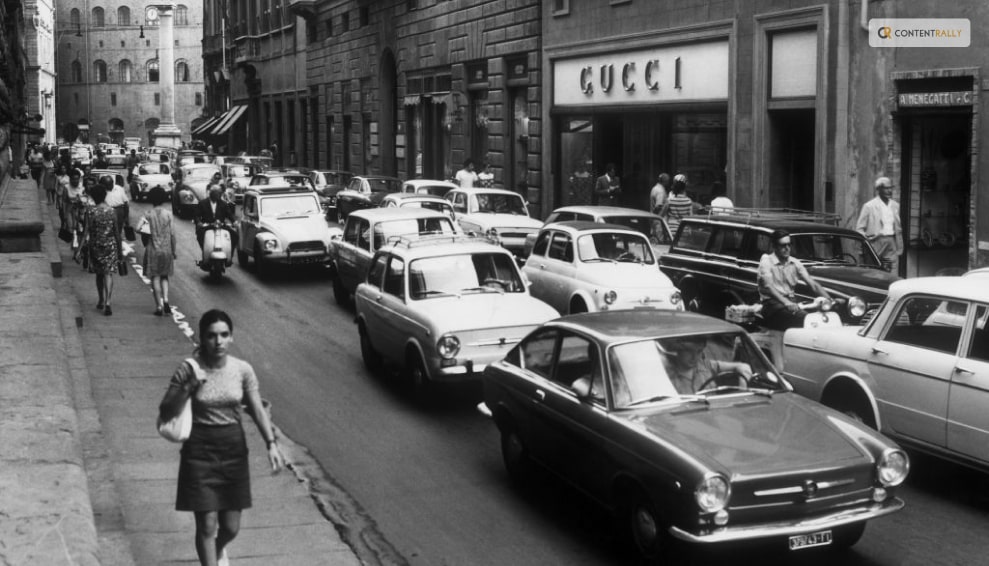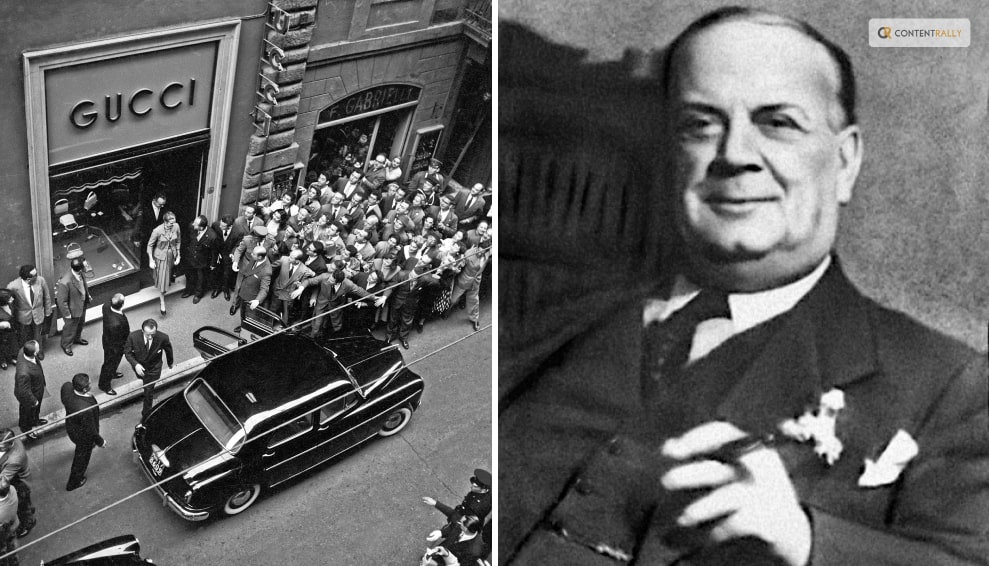Guccio Gucci, the founder of the Gucci house, established it in Florence in 1921. Prior to starting the now-famous brand, Guccio Gucci relocated to London and got employment as a luggage porter at the Savoy Hotel. It is one of the most opulent and prestigious establishments in the city, which catered to the wealthiest members of society.
It was here that he witnessed his future consumer market. He developed a profound understanding of what upper society sought in luxury goods. He excelled in the position at Franzi after returning to Florence and learning everything he could about leatherworking there.
Gucci ultimately made the decision, with the help of his wife and two boys, to pursue his dreams. They opened their first official store in Florence, their hometown, using a loan and savings.
Overview

Established: 1921
Headquarters: Florence, Italy
Founder: Guccio Gucci
CEO: Marco Bizzarri
Revenue: $13.66 billion
Who Owns Gucci Now: Early Days

In 1953, America got its first taste of an iconic fashion house as Jackie Kennedy carried an instantly famous Gucci bag. She was at her husband John F.’s presidential inauguration ceremony. The bag has been called ‘Jackie’ ever since. This event only propelled their reputation further within the U.S. market. It further added worldwide recognition to complement their popularity all across Europe.
The following ten years would prove even more prosperous as they commissioned the specially designed print scarf. It borrows its name “Flora” after Princess Grace of Monaco’s favorite flower when she visited the Gucci boutique in Milan. This creation of a staple item helped cement Gucci’s reputation in the upper echelons of society. In 1975, they expanded even further, opening their first fragrance line in the midst of fast growth.
Gucci launched itself throughout Europe and Japan (adding even more stores). Rodolfo Gucci took over the company’s management in 1982, and his son Maurizio managed it until 1995. By then, in 1987, the Gucci family had transferred 50% of its shares to Invest Corp shareholders. It completed the transfer of 100% ownership to Invest Corp in 1993.
Who Owns Gucci?

Kering, a French holding company, acquired a $8.8 billion stake in the renowned Italian fashion brand Gucci in 2004. Kering’s largest shareholder is Artémis, the Pinault family’s investment firm headed by François Pinault. It owns a majority stake in the business through its parent company. Gucci is one of the most profitable brands within the Kering Group. In 2022, its revenue exceeded €10.5 billion (roughly $12.7 billion). The group’s total revenue was €20 billion (roughly $21.1 billion).
Who Owns Gucci: Tom Ford Era

For the first time since 1921, a new designer took over the formerly family-owned fashion house of Gucci. Tom Ford formally became the creative director in 1994. With a focus on glamour, his debut collection for Fall 1995 restored Gucci’s reputation as a leading fashion brand. Ford has redefined the house’s identity and brought back its grandeur. He is also recognized for appropriating the Gucci name and reputation in that year.
With his seductive and opulent collections, Ford has continued to rule the 1990s. The transition has helped Gucci go from family dramas to a prosperous period.
Maurizio Gucci, the grandson and former head of Gucci, was assassinated in Milan in March 1995. In 1998, his ex-wife Patrizia Reggiani received a 29-year prison sentence. She was sentenced for masterminding the assassination of the Gucci heir.
The brand’s success can be attributed to Ford’s Fall 1995 collection. It featured hypersexual yet minimalist designs that celebrities adored, like Madonna, Jennifer Lopez, and Gwyneth Paltrow. They were all spotted sporting his clothing on the red carpet.
The adored Jackie bag made a comeback in 1999 in never-before-seen colors and variations. This officially led to the era of the Gucci “it” bag.
Does Guccio Gucci’s Family Still Own Gucci?

After Maurizio sold the entire company to Investcorp in 1993, the Gucci family no longer had any involvement in it. Currently, Kering, which owns 99% of the company, is the owner and operator of the business.
Who Has Taken The House Since?

Powerhouses LVMH and PPR (now Kering) fought for control of the fashion house in their respective domains in the late 1990s. Domenico De Sole, the company’s CEO at the time, resisted this, but LVMH started gradually acquiring Gucci shares. PPR swiftly rose to become Gucci’s largest shareholder before the company could fully take over, a position Gucci still holds today.
Ford hired Frida Giannini as head of accessories before he left in 2004 because of problems with PPR (Kering).
Who Owns Gucci: Recent Past

In 2006, Giannini became Gucci’s most recent creative director, bringing elegance to the brand by emphasizing the famed Flora print over the double G monogram.
Alessandro Michele became Gucci’s new creative director in 2015 after Giannini left the company in 2014. Michele, who worked for the brand for 12 years as an accessories designer, created a whole new menswear collection in less than a week. In Milan, he debuted his first womenswear line, Gucci, in Fall 2015. Even though he was a relatively unknown designer at the time, the fashion industry embraced his first runway collection.
Gucci’s classic heritage merged with Michele’s own eccentric style. His penchant for lavishness and extravagance has permeated the fashion house. In 2017, Gucci announced that it had set sales records under Michele’s direction. Michele has drawn in a whole new market of younger customers with her dreamy, poetic interpretation of luxury for the twenty-first century.
After seven years as Gucci’s creative director, Alessandro Michele announced his departure from the company on November 23 of this year. We’re interested to see who will succeed him and where the brand’s aesthetic will go. There is still more to come in Gucci’s history.
Gucci Net Worth?

Gucci broke previous records in sales in 2018 by reaching a milestone of 8 billion euros. Their strategic foray into younger markets, where consumers between the ages of 18 and 34 accounted for 65% of their sales, was largely responsible for their success.
In July 2020, its value was roughly $11.36 billion (€10.78 billion).
The Gucci brand’s estimated net worth as of 2022 was an astounding $18.1 billion, a huge rise from its October 2018 net worth of slightly over $11.55 billion (€10.96 billion).
Wrapping Up
Since the company’s founding in Florence in 1921, Gucci has undergone significant growth. From producing high-end travel accessories and equestrian equipment, it has developed into one of the most prosperous global luxury brands with a global reputation.
Their products, which range from ready-to-wear clothing to handbags and home décor, are available globally. Kering is the owner of Gucci, which is still a legendary fashion house with influence that extends well beyond Italy’s borders and will for many years to come.
If you have thoughts to share or questions to ask about who owns Gucci, please leave a comment below. We would love to hear from you!
Learn More About:





















